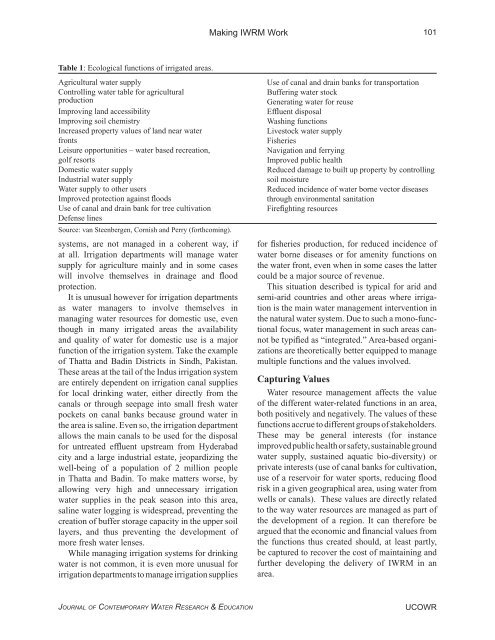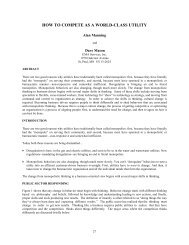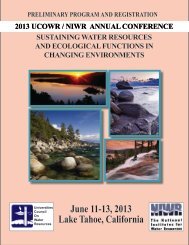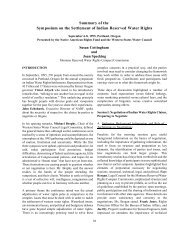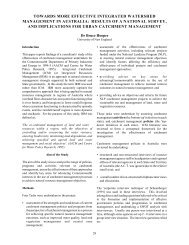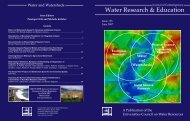100UNIVERSITIES COUNCIL ON WATER RESOURCESJOURNAL OF CONTEMPORARY WATER RESEARCH & EDUCATIONISSUE 135, PAGES 100-106, DECEMBER 2006From Value to Finance: Making IWRM WorkBen Lamoree <strong>and</strong> Frank van SteenbergenArcadis EuroconsultThe discussion on Integrated <strong>Water</strong>Resource Management (IWRM) has beenvery rich on institutional change (basinorganizations, apex water bodies, legal reform)<strong>and</strong> on process management (multi-stakeholderprocesses, consultation <strong>and</strong> participation), but attentionto the financial dimension <strong>of</strong> IWRM has been lessdeveloped.The gist <strong>of</strong> IWRM is that in water managementthere are many different functions to be managedsimultaneously. Through investment <strong>and</strong> managementinterventions, values are created (or destroyed)in connection to these functions: productivity values,amenity values, property values, environmentalconservation values, <strong>and</strong> more. The challenge inIWRM is to, at a minimum, balance these differentfunctions <strong>and</strong> values, yet preferably to optimizethem. This paper further argues that these differentvalues need to be captured <strong>and</strong>, when possible,help finance the management <strong>of</strong> water resourcesystems in an integrated way. We present this asan improvement <strong>of</strong> the principle <strong>of</strong> “water as aneconomic good.” The economic good argumenthas, in our view, <strong>of</strong>ten led to reductionist strategies,focusing on recovering the financial cost <strong>of</strong> wateronly <strong>and</strong> not maximizing <strong>and</strong> recovering the valuesassociated with the many functions <strong>of</strong> water.This paper first clarifies some definitions <strong>and</strong>then discusses how to capture values <strong>and</strong> turnthem into financial contributions to IWRM usingillustrations from several parts <strong>of</strong> the world. Thepaper then comments on the principle <strong>of</strong> water asan economic good, long considered as the financialunderpinning <strong>of</strong> IWRM. We look particularly atwater pricing for dem<strong>and</strong> management, closelyassociated with the theory <strong>of</strong> water as an economicgood. It argues that a broader financial strategy,based on balancing, improving, <strong>and</strong> capitalizingon increased values related to water management,is more promising in funding IWRM <strong>and</strong> makingit work. Finally, some institutional aspects <strong>of</strong> thisapproach are explored.Functions <strong>and</strong> ValuesThe concept <strong>of</strong> functions describes the goods<strong>and</strong> services the natural resource system providesor performs. There is almost always a wide range<strong>of</strong> functions associated with any given resourcesystem (Abdel Dayem et al. 2004). Table 1, forinstance, is a list <strong>of</strong> functions associated withirrigated areas. Other lists can be produced forother natural resource systems.Values is the concept through which societalpreferences, perceptions, <strong>and</strong> interests with regardto functions provided by natural resources areexpressed. These values are social, economic,financial <strong>and</strong> (temporal <strong>and</strong> spatial) ecologicalvalues. Values should not be seen separate fromstakeholders. They are not general <strong>and</strong> abstract,but they are always values to stakeholders. Thesemay be farmers, property owners, industries, localtowns, livestock owners, fishermen, <strong>and</strong> so forth<strong>and</strong>, in many cases, the public at large.The point <strong>of</strong> such lists is that there is usuallya large number <strong>of</strong> functions, many <strong>of</strong> which inpractice are overlooked in resource management,if only because the organizations that arepractically managing the resource have a limitedagenda <strong>and</strong> m<strong>and</strong>ate. In the management process,important opportunities to create value for variousstakeholders are missed.Quite typically the many functions in irrigationUCOWRJOURNAL OF CONTEMPORARY WATER RESEARCH & EDUCATION
Making IWRM Work101Table 1: Ecological functions <strong>of</strong> irrigated areas.Agricultural water supplyControlling water table for agriculturalproductionImproving l<strong>and</strong> accessibilityImproving soil chemistryIncreased property values <strong>of</strong> l<strong>and</strong> near waterfrontsLeisure opportunities – water based recreation,golf resortsDomestic water supplyIndustrial water supply<strong>Water</strong> supply to other usersImproved protection against floodsUse <strong>of</strong> canal <strong>and</strong> drain bank for tree cultivationDefense linesSource: van Steenbergen, Cornish <strong>and</strong> Perry (forthcoming).systems, are not managed in a coherent way, ifat all. Irrigation departments will manage watersupply for agriculture mainly <strong>and</strong> in some caseswill involve themselves in drainage <strong>and</strong> floodprotection.It is unusual however for irrigation departmentsas water managers to involve themselves inmanaging water resources for domestic use, eventhough in many irrigated areas the availability<strong>and</strong> quality <strong>of</strong> water for domestic use is a majorfunction <strong>of</strong> the irrigation system. Take the example<strong>of</strong> Thatta <strong>and</strong> Badin Districts in Sindh, Pakistan.These areas at the tail <strong>of</strong> the Indus irrigation systemare entirely dependent on irrigation canal suppliesfor local drinking water, either directly from thecanals or through seepage into small fresh waterpockets on canal banks because ground water inthe area is saline. Even so, the irrigation departmentallows the main canals to be used for the disposalfor untreated effluent upstream from Hyderabadcity <strong>and</strong> a large industrial estate, jeopardizing thewell-being <strong>of</strong> a population <strong>of</strong> 2 million peoplein Thatta <strong>and</strong> Badin. To make matters worse, byallowing very high <strong>and</strong> unnecessary irrigationwater supplies in the peak season into this area,saline water logging is widespread, preventing thecreation <strong>of</strong> buffer storage capacity in the upper soillayers, <strong>and</strong> thus preventing the development <strong>of</strong>more fresh water lenses.While managing irrigation systems for drinkingwater is not common, it is even more unusual forirrigation departments to manage irrigation suppliesUse <strong>of</strong> canal <strong>and</strong> drain banks for transportationBuffering water stockGenerating water for reuseEffluent disposalWashing functionsLivestock water supplyFisheriesNavigation <strong>and</strong> ferryingImproved public healthReduced damage to built up property by controllingsoil moistureReduced incidence <strong>of</strong> water borne vector diseasesthrough environmental sanitationFirefighting resourcesfor fisheries production, for reduced incidence <strong>of</strong>water borne diseases or for amenity functions onthe water front, even when in some cases the lattercould be a major source <strong>of</strong> revenue.This situation described is typical for arid <strong>and</strong>semi-arid countries <strong>and</strong> other areas where irrigationis the main water management intervention inthe natural water system. Due to such a mono-functionalfocus, water management in such areas cannotbe typified as “integrated.” Area-based organizationsare theoretically better equipped to managemultiple functions <strong>and</strong> the values involved.Capturing Values<strong>Water</strong> resource management affects the value<strong>of</strong> the different water-related functions in an area,both positively <strong>and</strong> negatively. The values <strong>of</strong> thesefunctions accrue to different groups <strong>of</strong> stakeholders.These may be general interests (for instanceimproved public health or safety, sustainable groundwater supply, sustained aquatic bio-diversity) orprivate interests (use <strong>of</strong> canal banks for cultivation,use <strong>of</strong> a reservoir for water sports, reducing floodrisk in a given geographical area, using water fromwells or canals). These values are directly relatedto the way water resources are managed as part <strong>of</strong>the development <strong>of</strong> a region. It can therefore beargued that the economic <strong>and</strong> financial values fromthe functions thus created should, at least partly,be captured to recover the cost <strong>of</strong> maintaining <strong>and</strong>further developing the delivery <strong>of</strong> IWRM in anarea.JOURNAL OF CONTEMPORARY WATER RESEARCH & EDUCATIONUCOWR
- Page 3:
Journal of ContemporaryWater Resear
- Page 6 and 7:
2Bruce Hooperinstitutional, and tem
- Page 11 and 12:
IWRM: Governance, Best Practice, an
- Page 13 and 14:
IWRM: Defi nitions and Conceptual M
- Page 15 and 16:
IWRM: Defi nitions and Conceptual M
- Page 17 and 18:
IWRM: Defi nitions and Conceptual M
- Page 19:
IWRM: Defi nitions and Conceptual M
- Page 22 and 23:
18Cardwell. Cole, Cartwright, and M
- Page 24 and 25:
20Mostert26 water boards responsibl
- Page 26 and 27:
22MostertTable 1. Third National Wa
- Page 28 and 29:
24MostertImplementationThe ambitiou
- Page 30 and 31:
26MostertBiswas, A. K. 2004b. Respo
- Page 32 and 33:
28UNIVERSITIES COUNCIL ON WATER RES
- Page 34 and 35:
30Ashton, Turton, and Rouxresource
- Page 36 and 37:
32Ashton, Turton, and Rouxassumptio
- Page 38 and 39:
34Ashton, Turton, and RouxEffective
- Page 40 and 41:
36UNIVERSITIES COUNCIL ON WATER RES
- Page 42 and 43:
38Hussey and Doversin water policy
- Page 44 and 45:
40Hussey and Dovers1994 Council of
- Page 46 and 47:
42Hussey and Doversestablished Thes
- Page 48 and 49:
44Hussey and DoversTable 1. Typolog
- Page 50 and 51:
46Hussey and Doversassessment appro
- Page 52 and 53:
48Hussey and Doverspolicy goals.Bey
- Page 54 and 55: 50Hussey and DoversFrawley, K. 1994
- Page 56 and 57: 52Mitchelloften took three to four
- Page 58 and 59: 54Mitchelltree preservation plans;
- Page 60 and 61: 56UNIVERSITIES COUNCIL ON WATER RES
- Page 62 and 63: 58Genskow and Borna series of chall
- Page 64 and 65: 60Genskow and BornTable 1. Watershe
- Page 66 and 67: 62Genskow and Bornthe first Dungene
- Page 68 and 69: 64Genskow and BornWashington, DC.Ko
- Page 70 and 71: 66Green and Fernández-BilbaoWithin
- Page 72 and 73: 68Green and Fernández-Bilbaosubjec
- Page 74 and 75: 70Green and Fernández-Bilbaoinflue
- Page 76 and 77: 72Green and Fernández-BilbaoBerbel
- Page 78 and 79: 74UNIVERSITIES COUNCIL ON WATER RES
- Page 80 and 81: 76BallweberEstablish AdvisoryCommit
- Page 82 and 83: 78Ballweberattributes in others (Ch
- Page 84 and 85: 80UNIVERSITIES COUNCIL ON WATER RES
- Page 86 and 87: 82Barreiraand ground water. To this
- Page 88 and 89: 84Barreirawith other states for int
- Page 90 and 91: 86UNIVERSITIES COUNCIL ON WATER RES
- Page 92 and 93: 88Davis and ThrelfallResource Manag
- Page 94 and 95: 90Davis and ThrelfallTable 2. Thirt
- Page 96 and 97: 92Davis and Threlfallby regional an
- Page 98 and 99: 94Davis and Threlfallenforcement, a
- Page 100 and 101: 96Davis and Threlfallhusbandry prac
- Page 102 and 103: 98Davis and ThrelfallNew Zealand: T
- Page 106 and 107: 102Lamoree and van SteenbergenIt is
- Page 108 and 109: 104Lamoree and van Steenbergenand n
- Page 110 and 111: 106Lamoree and van Steenbergeninter
- Page 112 and 113: 108BourgetWorks Planner Capability
- Page 114 and 115: 110Bourgetwith over 600 people resp
- Page 116 and 117: 112Bourgetgovernment’s intrusion
- Page 118 and 119: 114Bourget4.management, drought man
- Page 120 and 121: 116McKayFigure 1. The four paradigm
- Page 122 and 123: 118McKay4. Paradigm 4 (which commen
- Page 124 and 125: 120McKaythree main functions:1. ass
- Page 126 and 127: 122McKayState Implementation of the
- Page 128 and 129: 124McKayTable 2. Corporate governan
- Page 130 and 131: 126McKayFigure 4. Qu. 26 - The ESD
- Page 132 and 133: 128McKayFigure 7. Qu.93- This organ
- Page 134 and 135: 130McKayBrundtland Report. 1987. Ou
- Page 136 and 137: 132UCOWR BOARD OF DIRECTORS/COMMITT
- Page 138 and 139: 134BENEFITS OF UCOWR MEMBERSHIPThe
- Page 140 and 141: 136Past Issues of the Journal of Co
- Page 142 and 143: 138Academic Organizations Membershi
- Page 144 and 145: 140Individual Membership Applicatio
- Page 146 and 147: Universities Council on Water Resou
- Page 148: Integrated Water Resources Manageme


